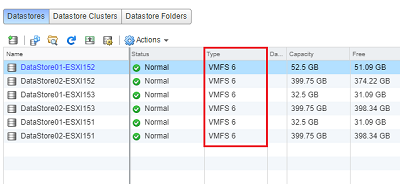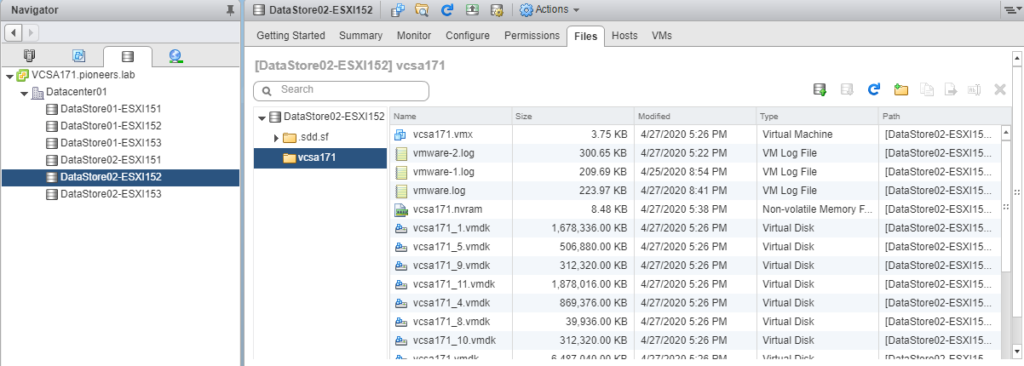What is a datastore?
DataStores in VMware vSphere are storage containers for files.
They could be located on a local server hard drive or across the network on a SAN.
DataStores hide the specifics of each storage device and provide a uniform model for storing virtual machine files.
DataStores are used to hold:
- virtual machine files,
- templates,
- and ISO images.
They can be formatted with VMFS (Virtual Machine File System, a clustered file system from VMware), or with a file system native to the storage provider (in the case of a NAS/NFS device).
To display DataStores information
In the image above you can see that there are two datastores available, both of which are formatted with VMFS5.
To view specific datastore details, double-click a datastore. To browse the files stores on the datastore, right-click and select Browse Files. You can delete, move, or upload files:
Virtual Machine File System (VMFS)
VMFS (Virtual Machine File System) is a clustered file system from VMware that provides storage virtualization.
VMFS offers many virtualization-based features, such as:
- concurrent access to shared storage. Multiple ESXi hosts can read and write to the same storage device at the same time.
- encapsulation of virtual machine’s files in directories.
- automatic restart of a failed VM on another ESXi host.
- migration of powered-on virtual machines from one ESXi host to another without downtime.
- clustering of VMs across different physical servers.
- VMFS datastore size can be increased while VMs residing on the datastore are running.
- when combined with shared storage, advanced vSphere features such as vMotion, DRS, HA, and FT are supported.
- support for thin-provisioned VMDK files, which allows VMFS datastores overallocation.
- support for RDM (Raw Device Mapping) devices.
VMFS can be created on three types of SCSI-based storage systems: direct-attached storage, FC storage, and iSCSI storage.
A virtual disk stored on a VMFS datastore will appear to the virtual machine as a mounted SCSI device.
The operating system running inside the VM will see its native file system, not VMFS.
The current VMFS version is VMFS-6. This version uses 1MB block size and can support VMDK files of up to 62TB.
You can have up to 256 VMFS datastores per host, with the maximum size of 64TB.
Raw Device Mapping (RDM)
Sometimes : storage device must be presented directly to the guest operating system inside a VM.
In VMware vSphere, this functionality is provided via a raw device mapping (RDM), which is a file stored on a VMFS volume that acts as a proxy for the raw physical device.
Virtual machine data is stored directly on the storage area network device, as opposed to storing it in a VMDK file on a VMFS datastore.
An RDM file is created on a VMFS datastore and points to the raw device. The file has a .vmdk extension and contains only the mapping information and not the actual data.
Storing the data this way is useful if you are running applications in your virtual machines that are SAN-aware and must know the physical characteristics of the SAN storage device.
RDMs are also used with Microsoft Cluster Service (MSCS).
You can use RDMs in two different modes:
- Physical– the VMkernel passes through all SCSI commands with the exception of the REPORT LUNs command. This RDM mode is used when running SAN-aware applications in a virtual machine. Note that physical mode RDMs can’t be included in a vSphere snapshot.
- Virtual– allows the guest OS to treat the RDM more like a virtual disk. Virtual mode RDMs can be included in a vSphere snapshot.
Conclusion
in first two articles of ESXI storage : we have got an overview about
- storage type and it’s protocol
- DataStore
- VMFS
- Raw Disk Mapping RDM
in next articles : we will see how how to [create and configure as well as manage] storage



